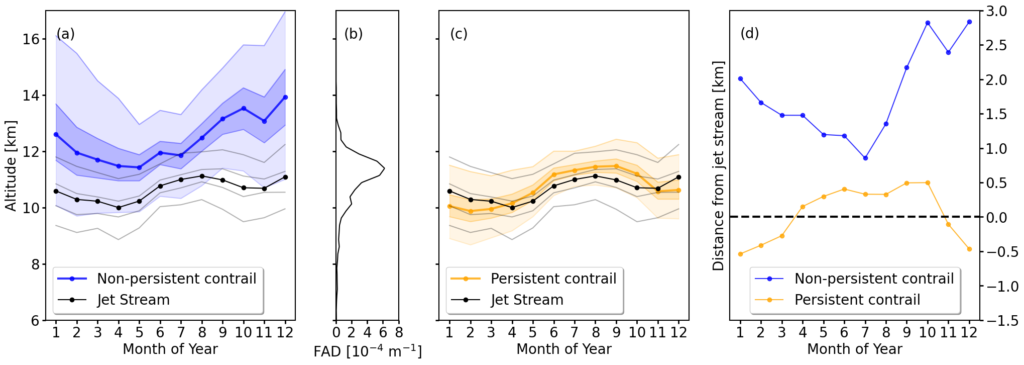The article written by Kevin Wolf, Nicolas Bellouin and Olivier Boucher can be found at:
https://acp.copernicus.org/articles/23/287/2023/acp-23-287-2023.html
Within the last one hundred years, air travel became a commodity and the number of flights increased each year. This comes with a cost and global aviation contributes to climate warming by multiple factors. The first factor that comes into one’s mind is CO2, with aviation being responsible for 2.5 to 2.6% of the total anthropogenic CO2 fossil fuel emissions in 2018 (Friedlingstein et al (2019), Lee et al (2021), Boucher et al (2021)). In addition to CO2, the combustion of fossil fuel in jet engines releases significant amounts of water vapor into the atmosphere.
The additional water vapor can form condensation trails, also termed contrails, that emerge behind aircraft (Schumann (1996), Kärcher (2018)). Most of the time these contrails vanish within a few seconds or minutes but they can be persistent up to a day depending on the environmental conditions (Jensen et al (1994), Schumann (1996), Haywood et al (2009)).
Whether a contrail can develop in the first place is usually estimated with the Schmidt-Appleman criterion (SAc; Schmidt (1941), Appleman (1953)). If the ambient air is moist and cold enough then the liquid water droplets in the exhaust plume freeze into ice crystals and form the contrail. For these artificial clouds to be persistent the ambient air must be additionally supersaturated with respect to ice in so called ice supersaturated regions (ISSR).
While contrails seem to be negligible, climate models and satellite observations suggest that contrails artificially increase the global cloud cover by 6 to 10% in northern hemisphere mid-latitudes with consequential effects on global climate (Burkhardt and Kärcher (2011), Quaas et al (2021)). Even though the exact magnitude depends on the ambient conditions, in most cases contrails heat the Earth atmosphere. Therefore, contrail formation should be avoided.
We analyzed an eight-year dataset of radiosonde (RS) observations launched from Trappes, France. The available RS profiles were flagged for their potential to host non-persistent contrails (NPC) and persistent contrails (PC). For this study we introduced a new, third category, labeled as “reservoir”, which does not fulfill the SAc but is nevertheless ice supersaturated. This reservoir provides an estimate for the potential spreading of existing contrails beyond the regions prone to NPC and PC formation.
An interesting and counter-intuitive fact: Making jet engines more efficient will generally increase the chance for contrail formation. The increased efficiency leads to a colder exhaust plume that contains the same amount of water vapor and, as a result, can form contrails at higher ambient temperature and more often. While more efficient engines emit less CO2 into the atmosphere, the higher frequency of contrails can contribute to climate warming.
Using the RS profiles from Trappes and separating for NPC, PC, and R situations, we found the highest frequency of occurrence for NPC that appear in up to 60% of all profiles during winter. Contrarily, a minimum is reached in summer. PC generally appear less frequent and are identified in 30 to 40% of the profiles throughout the entire year. The reservoir conditions are even rarer and found in approximately 20% of the profiles.
To estimate the actual occurrence of contrails we combined the information about the contrail formation potential with the actual flight traffic over Paris. The resulting profiles are still dominated by NPC, especially in winter and spring. For summer an increasing significance of PC is determined, as they overlap with the altitude of highest air traffic. The reservoir category occurs only in summer and autumn, and is negligible in other seasons.
To answer the question if flying at higher or lower altitudes to avoid contrails, today’s air traffic distribution is shifted. Increasing the flight altitude by 0.8 km reduces contrail formation in winter, while a reduction in flight altitude during summer is required to minimize potential contrail formation. Nevertheless, one has to keep in mind that aircraft already operate within their optimal altitude range and the maximum deviations towards lower or higher altitudes are limited by increasing air density and aerodynamic drag (lower boundary) as well as flying into the stratosphere (upper boundary).
We further examined linkages of contrail formation with the thermal tropopause (TT) and the jet stream (strong persistent winds at around 10 km altitude in which aircraft tend to fly to save fuel). The median altitude of NPC is located at the TT (summer) and up to 1.5 km above the TT (winter). NPC are located between -2 km (winter) and -1 km below the TT (summer). With respect to the jet stream, the median altitude of NPC is 2 km (winter) and 1 km (summer) above the jet stream. PC are identified to be at the same altitude as the jet stream also following the inter-annual variation in jet stream location.

The aviation industry aims to become more environmentally friendly and started to develop new propulsion systems that use alternative fuels like ethanol, methane, or hydrogen. These fuels have other characteristics than today’s kerosene and, therefore, other thresholds for contrail formation. In the described study we assume that hydrogen is burned in engines that are comparable with today’s technology, rather than used in a fuel cell. Based on that we estimated the influence of these fuels on the likelihood of potential contrail formation. Switching to either of the alternative fuels leads to a general increase in potential contrails, particularly of NPC. The largest increase was found for hydrogen with an increase of 155% in summer. For PC the increase is less significant. Combining the minor increase in PC formation and the potentially CO2 – neutral hydrogen fuel, if produced with renewable energy, makes hydrogen powered aircraft an appealing solution.
We would like to guide the interested reader to the publication that is linked above and that contains all details of the study.
